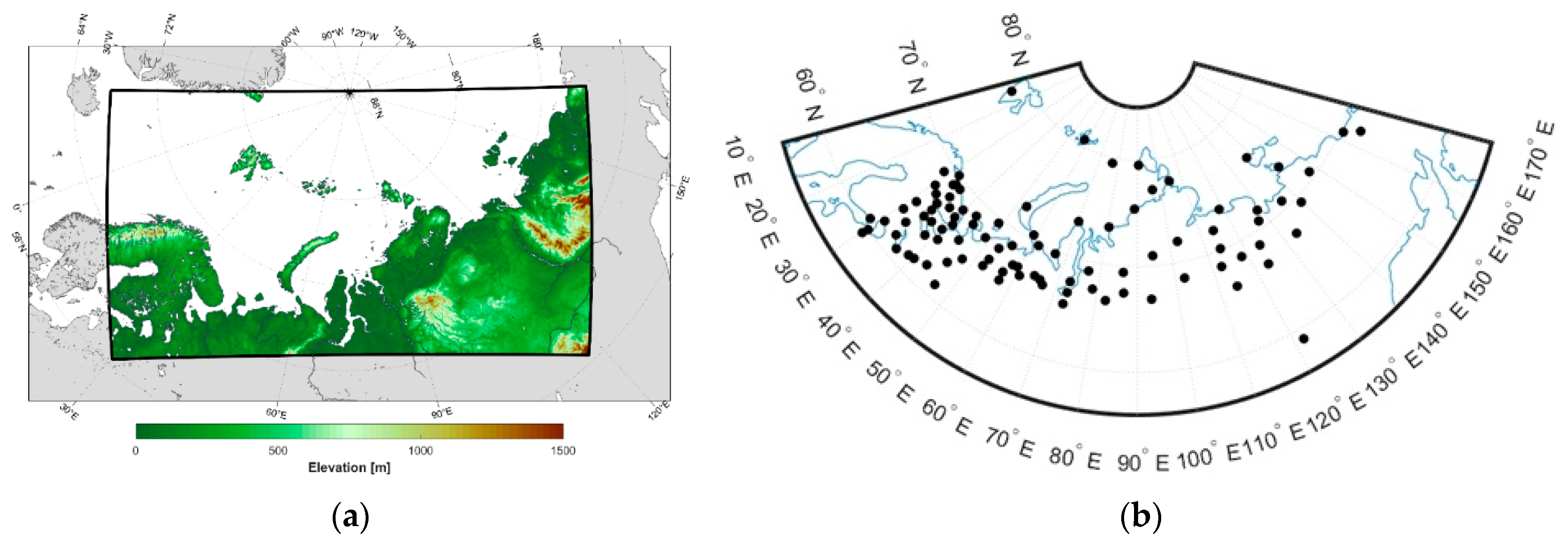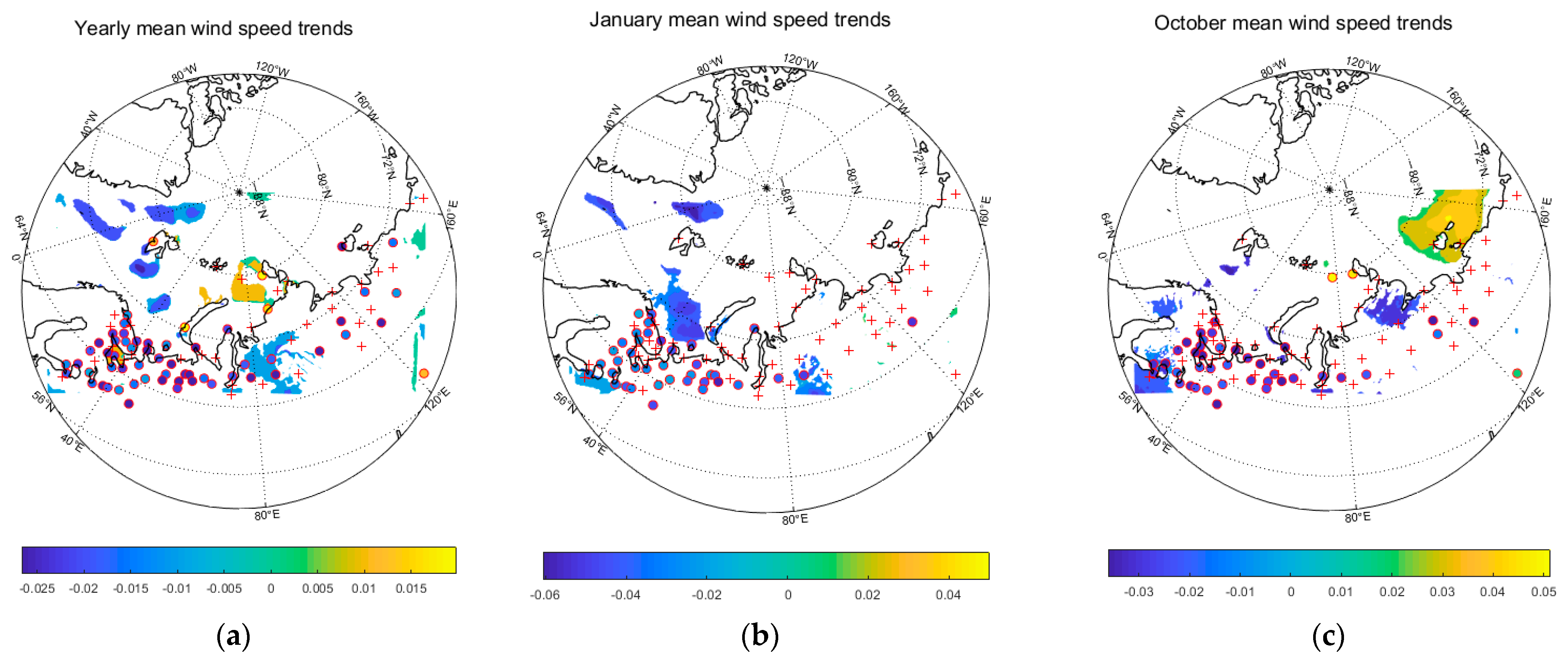Extreme Wind Speed Long-Term Trends Evaluation in the Russian Arctic Based on the COSMO-CLM 36-Year Hindcast †
Abstract
:1. Introduction
2. Materials and Methods
2.1. COSMO-CLM Russian Arctic Hindcast
2.2. Weather Stations Data
3. Results and Discussion
3.1. Mean Wind Speed
3.2. Extreme Wind Speed
3.3. Wind Speed Occurrences
3.4. Discussion
4. Conclusions
Author Contributions
Funding
Institutional Review Board Statement
Informed Consent Statement
Data Availability Statement
Acknowledgments
Conflicts of Interest
References
- Screen, J.A.; Deser, C.; Simmonds, I. Local and remote controls on observed Arctic warming. Geophys. Res. Lett. 2012, 39, 10. [Google Scholar] [CrossRef]
- Serreze, M.C.; Barrett, A.P.; Stroeve, J.C.; Kindig, D.M.; Holland, M.M. The emergence of surface-based Arctic amplification. Cryosphere 2009, 3, 11–19. [Google Scholar] [CrossRef]
- IPCC. Climate Change 2021: The Physical Science Basis. Contribution of Working Group I to the Sixth Assessment Report of the Intergovernmental Panel on Climate Change; Masson-Delmotte, V., Zhai, P., Pirani, A., Connors, S.L., Péan, C., Berger, S., Caud, N., Chen, Y., Goldfarb, L., Gomis, M.I., Huang, M., Leitzell, K., Lonnoy, E., Matthews, J.B.R., Maycock, T.K., Waterfield, T., Yelekçi, O., Yu, R., Zhou, B., Eds.; Cambridge University Press: Cambridge, UK; New York, NY, USA, 2021; p. 2391. [Google Scholar] [CrossRef]
- Bekryaev, R.V.; Polyakov, I.V.; Alexeev, V.A. Role of polar amplification in long-term surface air temperature variations and modern Arctic warming. J. Clim. 2010, 23, 3888–3906. [Google Scholar] [CrossRef]
- Stroeve, J.C.; Serreze, M.C.; Holland, M.M.; Kay, J.E.; Malanik, J.; Barrett, A.P. The Arctic’s rapidly shrinking sea ice cover: A research synthesis. Clim. Chang. 2011, 110, 1005–1027. [Google Scholar] [CrossRef]
- Brennan, M.K.; Hakim, G.J.; Blanchard-Wrigglesworth, E. Arctic Sea-Ice Variability During the Instrumental Era. Geophys. Res. Lett. 2020, 47, 7. [Google Scholar] [CrossRef]
- Walsh, J.E.; Fetterer, F.; Scott Stewart, J.; Chapman, W.L. A database for depicting Arctic sea ice variations back to 1850. Geogr. Rev. 2017, 107, 89–107. [Google Scholar] [CrossRef]
- Maksym, T. Arctic and Antarctic Sea Ice Change: Contrasts, Commonalities, and Causes. Annu. Rev. Mar. Sci. 2019, 11, 187–213. [Google Scholar] [CrossRef]
- Barnes, E.A. Revisiting the evidence linking Arctic amplification to extreme weather in midlatitudes. Geophys. Res. Lett. 2013, 40, 4734–4739. [Google Scholar] [CrossRef]
- Francis, J.A.; Vavrus, S.J. Evidence linking Arctic amplification to extreme weather in mid-latitudes. Geophys. Res. Lett. 2012, 39, 6. [Google Scholar] [CrossRef]
- Bliss, A.C.; Miller, J.A.; Meier, W.N. Comparison of passive microwave-derived early melt onset records on Arctic sea ice. Remote. Sens. 2017, 9, 199. [Google Scholar] [CrossRef]
- Parkinson, C.L. Spatially mapped reductions in the length of the Arctic sea ice season. Geophys. Res. Lett. 2014, 41, 4316–4322. [Google Scholar] [CrossRef] [PubMed]
- Peng, X. Spatiotemporal changes in active layer thickness under contemporary and projected climate in the Northern Hemisphere. J. Clim. 2018, 31, 251–266. [Google Scholar] [CrossRef]
- Smirnova, J.E.; Golubkin, P.A.; Bobylev, L.P.; Zabolotskikh, E.V.; Chapron, B. Polar low climatology over the Nordic and Barents seas based on satellite passive microwave data. Geophys. Res. Lett. 2015, 42, 5603–5609. [Google Scholar] [CrossRef]
- Zahn, M.; von Storch, H. A long-term climatology of North Atlantic polar lows. Geophys. Res. Lett. 2008, 35, L22702. [Google Scholar] [CrossRef]
- LaffiLaffineur, T.; Claud, C.; Chaboureau, J.-P.; Noer, G. Polar lows over the Nordic seas: Improved representation in ERA-Interim compared to ERA-40 and the impact on downscaled simulations. Mon. Weather. Rev. 2014, 142, 2271–2289. [Google Scholar] [CrossRef]
- Noer, G.; Saetra, Ø.; Lien, T.; Gusdal, Y. A climatological study of polar lows in the Nordic Seas. Q. J. R. Meteorol. Soc. 2011, 137, 1762–1772. [Google Scholar] [CrossRef]
- Overland, J.E.; Wang, M. Large scale atmospheric circulation changes are associated with the recent loss of Arctic sea ice. Tellus A 2010, 62, 1–9. [Google Scholar] [CrossRef]
- Ivanov, V.; Alexeev, V.; Koldunov, N.V.; Repina, I.; Sandø, A.B.; Smedsrud, L.H.; Smirnov, A. Arctic Ocean heat impact on regional ice decay—A suggested positive feedback. J. Phys. Oceanogr. 2015, 46, 1437–1456. [Google Scholar] [CrossRef]
- Zabolotskikh, E.V.; Gurvich, I.A.; Chapron, B. New areas of polar lows over the Arctic as a result of the decrease in sea ice extent. Atmos. Ocean. Phys. 2015, 51, 1021–1033. [Google Scholar] [CrossRef]
- Hall, R.; Erdélyi, R.; Hanna, E.; Jones, J.M.; Scaife, A.A. Drivers of North Atlantic polar front jet stream variability. Int. J. Clim. 2015, 35, 1697–1720. [Google Scholar] [CrossRef]
- Moore, G.W.K.; Renfrew, I.A. Tip jets and barrier winds: A QuikSCAT climatology of high wind speed events around Greenland. J. Clim. 2005, 18, 3713–3725. [Google Scholar] [CrossRef]
- Shestakova, A.A.; Myslenkov, S.A.; Kuznetsova, A.M. Influence of Novaya Zemlya Bora on Sea Waves: Satellite Measurements and Numerical Modeling. Atmosphere 2020, 11, 726. [Google Scholar] [CrossRef]
- Christakos, K.; Furevik, B.R.; Aarnes, O.J.; Breivik, Ø.; Tuomi, L.; Byrkjedal, Ø. The importance of wind forcing in fjord wave modelling. Ocean Dyn. 2020, 70, 57–75. [Google Scholar] [CrossRef]
- Gutjahr, O.; Heinemann, G. A model-based comparison of extreme winds in the Arctic and around Greenland. Int. J. Clim. 2018, 38, 5272–5292. [Google Scholar] [CrossRef]
- Shestakova, A.A.; Toropov, P.A.; Matveeva, T.A. Climatology of extreme downslope windstorms in the Russian Arctic. Weather. Clim. Extremes 2020, 28, 100256. [Google Scholar] [CrossRef]
- Willmes, S.; Heinemann, G.; Schnaase, F. Patterns of wintertime Arctic sea-ice leads and their relation to winds and ocean currents. Cryosphere 2023, 17, 3291–3308. [Google Scholar] [CrossRef]
- Casas-Prat, M.; Wang, X.L. Sea ice retreat contributes to projected increases in extreme Arctic ocean surface waves. Geophys. Res. Lett. 2020, 47, 15. [Google Scholar] [CrossRef]
- Myslenkov, S.; Platonov, V.; Kislov, A.; Silvestrova, K.; Medvedev, I. Thirty-nine-year wave hindcast, storm activity, and probability analysis of storm waves in the Kara Sea, Russia. Water 2021, 13, 648. [Google Scholar] [CrossRef]
- Platonov, V.; Varentsov, M. Introducing a New Detailed Long-Term COSMO-CLM Hindcast for the Russian Arctic and the First Results of Its Evaluation. Atmosphere 2021, 12, 350. [Google Scholar] [CrossRef]
- Platonov, V.; Varentsov, M. Creation of the long-term high-resolution hydrometeorological archive for Russian Arctic: Methodology and first results. In IOP Conference Series: Earth and Environmental Science; IOP Publishing: Bristol, UK, 2019; Volume 386. [Google Scholar] [CrossRef]
- Platonov, V.; Varentsov, M. A new detailed long-term hydrometeorological dataset: First results of extreme characteristics estimations for the Russian Arctic seas. In IOP Conference Series: Earth and Environmental Science; IOP Publishing: Bristol, UK, 2020; Volume 611. [Google Scholar] [CrossRef]
- Data from the COSMO-CLM Russian Arctic Hindcast Archive, Figshare Repository. Available online: https://figshare.com/collections/Arctic_COSMO-CLM_reanalysis_all_years/5186714 (accessed on 10 September 2023).
- Platonov, V.; Boiko, A. COSMO-CLM Russian Arctic hindcast, 1980–2016: Surface wind speed evaluation and future perspectives. Environ. Sci. Proc. 2022, 19, 39. [Google Scholar] [CrossRef]
- Russian Research Institute for Hydrometeorological Information—World Data Center. Available online: http://aisori-m.meteo.ru/ (accessed on 10 September 2023).



Disclaimer/Publisher’s Note: The statements, opinions and data contained in all publications are solely those of the individual author(s) and contributor(s) and not of MDPI and/or the editor(s). MDPI and/or the editor(s) disclaim responsibility for any injury to people or property resulting from any ideas, methods, instructions or products referred to in the content. |
© 2023 by the authors. Licensee MDPI, Basel, Switzerland. This article is an open access article distributed under the terms and conditions of the Creative Commons Attribution (CC BY) license (https://creativecommons.org/licenses/by/4.0/).
Share and Cite
Platonov, V.; Kozlov, F.; Boiko, A. Extreme Wind Speed Long-Term Trends Evaluation in the Russian Arctic Based on the COSMO-CLM 36-Year Hindcast. Environ. Sci. Proc. 2023, 27, 6. https://doi.org/10.3390/ecas2023-15126
Platonov V, Kozlov F, Boiko A. Extreme Wind Speed Long-Term Trends Evaluation in the Russian Arctic Based on the COSMO-CLM 36-Year Hindcast. Environmental Sciences Proceedings. 2023; 27(1):6. https://doi.org/10.3390/ecas2023-15126
Chicago/Turabian StylePlatonov, Vladimir, Fedor Kozlov, and Aksinia Boiko. 2023. "Extreme Wind Speed Long-Term Trends Evaluation in the Russian Arctic Based on the COSMO-CLM 36-Year Hindcast" Environmental Sciences Proceedings 27, no. 1: 6. https://doi.org/10.3390/ecas2023-15126
APA StylePlatonov, V., Kozlov, F., & Boiko, A. (2023). Extreme Wind Speed Long-Term Trends Evaluation in the Russian Arctic Based on the COSMO-CLM 36-Year Hindcast. Environmental Sciences Proceedings, 27(1), 6. https://doi.org/10.3390/ecas2023-15126





